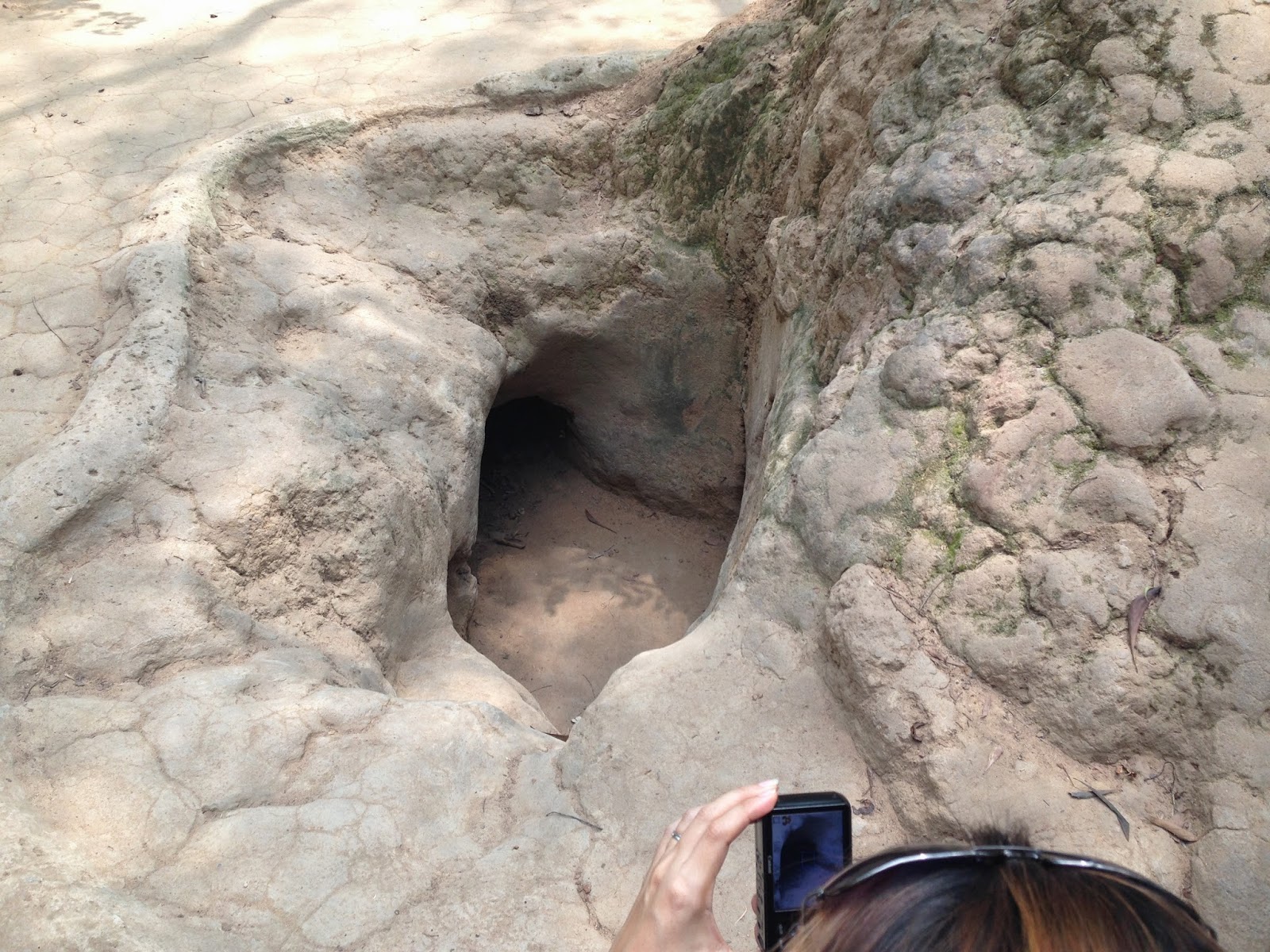One of the more famous sights to see when visiting the HCMC area is the Cu Chi Tunnels in the Cu Chi district some 2 hours north of the city center (and yet, amazingly, still within the city limits of Saigon).
Earlier this year, my good friends Alex and Liz took a Sibling Trip to Vietnam and we visited this unique site. It was sweltering hot, but we got a great half-day trip in and a fairly tolerable guide (sometimes the heat, non-stop narration, aggressive attempts to include you, and annoying co-tourists make you just want to punch them in their tourist-guide faces, but we got a little lucky this time around).
Together, we wound our way through a piece of our shared American/Vietnamese history, and learned just a little bit more about how the American War shaped an influential cadre of Vietnamese
Click through for pictures and (just a little bit of) history!
Tunnels
Entrances were well hidden, and included many fakeouts to throw soldiers off the scent. Even after a campaign that targeted entrances by tossing in grenades, the system proved incredibly resilient, with seemingly an unlimited amount of escape holes, dead ends, and booby traps.
Today, these tunnel entrances have been widened and made taller to accommodate tourists - as well as building descending staircases. These tourist tunnels are all first tier tunnels (there are three levels of tunnels depending on the intended purpose and terrain).
You can go up to 100 meters through the tunnels, coming out into an operating room. Here I am in the operating room, looking back at the SCARY ASS TUNNEL that I just came out of. I honestly can't believe I went in that thing!
Medical conditions were not good in the tunnels. An estimated 100% of Viet Cong living in the tunnels had serious parasite problems, and at any time there were many ill soldiers, families, and children.
Agent Orange was developed and released in part to defoliate the jungle, scraping away the hiding places that were available for Viet Cong and exposing the tunnels, which American commanders recognized as a serious military advantage for the Viet Cong. Every trace of the tunnels was designed to be completely innocuous from the air. Above is a chimney for the nearby kitchen and mess hall, which was designed to spread smoke from fires out and away from living areas. This mound is only about 12 inches high and looks like nothing from above.
Traps
The Viet Cong populated dead ends, entrances, fakeout store rooms and the jungle at large with some seriously messed up - and effective - traps. These guys were NOT KIDDING AROUND. Check these out! Scary!!
There were examples of all the traps devised for the war. They largely speak for themselves... so I'll let them.
Most traps were made from scrap reclaimed from American forces as they were swarmed and subdued. There were entire foundries located beneath the Cu Chi District where Viet Cong would fashion old bayonets, tanks, and bombs into pieces of lethal traps.
Eeech.
Ugh. Just... man.
This one gets you when you go down, and then AGAIN when you get pulled out. Not taking any chances, I guess.
This is modeled on an actual traditional trap used for fish. Just as effective, I'd guess! A person gets in... but there's really no getting out without massive bodily damage.
Walking through the jungle must have been like a adrenaline-a-thon - not knowing what to expect, where to look, or how to find those horrifying traps you keep hearing about from your brothers must have been alarming.
And this ones for placing inside huts. When the GIs burst in, the ball and spikes would swing down and impale. Because More Body Horror, Please.
Tanks and Training
Viet Cong spent most of their nights building and fashioning traps, bombs, and more defensive and offensive measures to defend the Cu Chi District. These are models of the foundries they utilized and what they would have looked like at work.
Today there are many fewer unexploded bombs (UXO) in Vietnam, but it remains a problem. These have been procured from the district where they landed and defused to give an idea of the kind of weaponry the Viet Cong were fighting.
Tourism Time
This would definitely NOT be a Vietnamese state monument without something for the kiddies - how about the chance to shoot AK-47s and other heavy artillery! Alex partook, but I had a bit of a headache from the heat. No thanks to the constant sound of guns.
This is the Vietnamese version of moonshine. Beware! It's got a real bad kick!
Shoes made from tires were for sale, handcrafted in the same manner that the Viet Cong used during the War.
Bombs Everywhere!
If you get a chance, do go look around - it's hot and stuffy, but a fairly interesting historical footnote and not far from HCMC.
Have you seen the Tunnels? What crazy things did I miss?






























No comments:
Post a Comment
Hi! Thanks for speaking up! :) - Ben